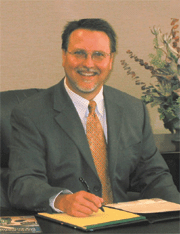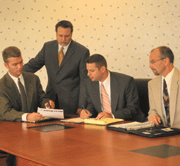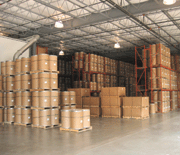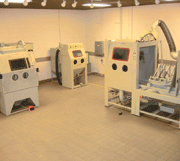E-Archive
Interview
in Vol. 6 - November Issue - Year 2005
Plastic Is Tough Enough

Michael A. Golubski, President, Maxi-Blast, Inc.

Pictured From Left To Right: Frank W. Kuhlman, International Sales Manager, Michael A. Golubski, President, Mikael J. Szymarek, Eastern Regional Sales Engineer, John M. Todd-South/Western Regional Sales Engineer. A Special Project Requires Input From Team Members.

The Maxi-Blast Warehouse Has Many Tons Of Finished Product Ready For Shipment

The Maxi-Blast Media Testing And Machine Demonstration Laboratory
An interview with Michael A. Golubski, President of Maxi-Blast, Inc., a company that is entirely focused on the manufacturing and distribution of plastic media.
(?) MFN: Would you please provide us with some history on Maxi-Blast, Inc.
(!) M. G.: Maxi-Blast started in 1980 as a company solely dedicated to supplying high quality plastic blast media. At that time no other companies focused solely on plastic blast media. There were a few companies supplying one or two types of plastic media, or selling plastic media along with various other abrasives and machines. So, the idea was to be very specialized and work only with plastic blast media and Maxi-Blast has for the most part stuck to that original premise.
(?) MFN: What are Maxi-Blast’s primary markets at this point in time?
(!) M. G.: Since plastic media is somewhat of a niche business there are specific areas where plastic blast media are used. The first known application for plastic blast media was for deflashing thermoset plastic parts. It used to be that the only material available for deflashing plastic parts was ground walnut shells or ground apricot pits. It was discovered that polycarbonate and polyamide plastic material which are very durable plastics, could be extruded into small pellets and could be used as a blasting media in any conventional blast equipment to deflash plastic parts. Some companies still use walnut shell, but by far the polycarbonate and polyamide type blast media are the preferred methods for deflashing thermoset plastic parts.
The other industry where plastic blast media is used quite extensively is in the rubber industry. To deflash rubber parts, polycarbonate type blast media is utilized, because the polycarbonate media withstands the very cold temperatures present in cryogenic shot blast deflashing machines. In this application, rubber parts are placed into a tumbling chamber, and liquid nitrogen is then injected into the blast chamber, freezing the parts. Simultaneously, the plastic blast media is propelled at the parts via a wheel/turbine blast method, breaking off the flash. When the parts emerge from the machine they are deflashed and fully finished. Also, granulated plastic media, such as those made from urea and melamine (generically referred to as type II and type III), are blasted in conventional pressure blast systems to clean molds. Previously, molders would use a mild abrasive such as glass bead but this was found to erode the mold quickly. When it was discovered that plastic media could clean molds with little to no erosion of the steel, it quickly became a mainstay in the rubber industry.
(?) MFN: What about plastic media for paint stripping? We hear a lot about the use of plastic media for stripping aircraft and aerospace components.
(!) M. G.: Yes, this is another of the applications for plastic blast media. In the mid 1980’s the US Military gave plastic blast media a huge boost in popularity when they approved it as an alternative to chemical stripping of aircraft and aircraft parts. Currently there is a very large market segment in the military and aerospace that use plastic media for stripping any type of paint and coatings. If a plastic media manufacturer wants to participate in this business they must have mil-spec approval, and then they are able to supply aerospace companies and military bases around the world. Plastic media is sensitive enough so that when proper blasting techniques are employed on parts with multiple coatings you can actually remove the paint layer by layer with no damage to the substrate. One of the most common aerospace applications is stripping anodized aluminum wheels. Previously, chemicals were commonly used to strip the paint but this method created a lot of chemical effluent. Now, the repair shops of the military and of the major airlines can place aircraft parts such as wheels and landing gear into a pressure blast cabinet and within minutes strip the coatings without removing the anodizing or harming the substrate.
Another industrial application for plastic media is the stripping of powder coatings. Powder Coating was developed as an environmentally friendly answer to conventional wet spray-on type painting. Spray paints can contain up to 95% VOC’s (Volatile Organic Compounds such as toluene). Manufacturers who switch to the powder coating method do not emit VOC’s into the atmosphere and it is therefore much better for the environment. The process of Powder coating is basically spraying electrostatically charged powdery particles of plastic onto a part and then baking the parts in an oven until it melts producing a very tough ‘paint’ or ‘powder coating’. The downside for manufacturers was that this coating was very difficult to remove compared to wet paint. Plastic blast media met the challenge of stripping these parts after it was found that the unique chipping and cutting action could quickly and efficiently strip powder coated parts. When stripped, these parts could be reprocessed through the paint booth with no extra sanding, wiping or polishing. The stripping of powder coatings is a very widely used method in the US, but for some reason has not really caught on in Europe. Maxi-Blast is currently working to change this.
Maxi-Blast is in the process of gaining CE approval on our specialized high volume pressure blast systems. With the CE mark on our pressure blast systems, we will be able to market our stripping and mold cleaning machines in Europe. These machines have a very good and efficient cyclone separator and dust collector designed to separate the long lasting plastic media from the dust that is created. Most conventional sand blast cabinets that work fine with abrasives such as glass bead and aluminum oxide just will not strip parts properly with plastic media.
(?) MFN: We understand that plastic blast media can be used for deburring? We always thought that ‘steel shot’ was the ideal material for that application.
(!) M. G.: Yes, steel shot is ideal for deburring and peening many parts and the fact is that plastic media does not compete in any way with steel shot. Plastic blast media is used for deburring small precision aluminum or zinc die castings that have light flash. The flash or burr in this instance is similar to plastic molded parts with light flash. A manufacturer can put these precision parts into a blast system and the plastic media will quickly and efficiently deburr the parts without damage or any change to the surface of the part. This process can be accomplished on zinc and aluminum die castings in a normal blast system at room temperature, or a manufacturer can utilize a cryogenic deflashing system similar to the ones mentioned earlier for deflashing rubber parts. Zinc parts in particular can be cryogenically deflashed in the same manner as rubber parts (since zinc flash actually becomes more brittle in a cryogenic atmosphere approx. -100° F/-74°C).
Another common deburring application for plastic blast media is the deburring of machined metal parts. Steel and aluminum castings are commonly produced for automotive engines and transmissions. It is often necessary to machine these parts to meet very close tolerances. When machining these metal parts, very small and brittle burrs are created at the edges of the machining line. Many companies use plastic blast media in automated air-blast style or a wheel/turbine blast machines to deburr these types of parts. The burrs readily break off on impact with the tough plastic particles, and the parts then emerge from the blast machine and look as if nothing had touched them. In other words, the machining lines are still there and the very flat service is maintained, but the plastic media has very efficiently removed the burrs. This process is widely used in the engine and transmission manufacturing plants.
(?) MFN: You seem to know a lot about of all types of blast machines yet I understand you do not sell automated blast machines, is this correct?
(!) M. G.: True, Maxi-Blast does not produce or sell any automated blast equipment and that is where our very good relationship with automated blast equipment manufacturers has helped. In the United States, Maxi-Blast maintains cordial relations with automated machine manufacturers who are able to manufacture deburring machines for any type of part that needs to be deburred. A great effort is made to put potential customers together with the companies that build automated equipment. Afterward, Maxi-Blast will provide the plastic blast media to the manufacturers who purchase the automated equipment. Maxi-Blast would really like to partner with a few manufacturers in Europe and work out the same type of synergistic relationship. These relationships benefit both parties because more machines are sold as well as more Maxi-Blast media.
(?) MFN: How does Maxi-Blast accomplish supplying blast media around the world?
(!) M. G.: Maxi-Blast has four sales people that cover the U.S. on primarily a direct sales basis. In countries outside of the U.S., maintaining local stock and knowledgeable customer service is a must. Therefore we have distributors in nearly every industrialized country who stock our plastic media. One key to the success of Maxi-Blast is that we insist that all of our Sales Engineers and Distributors are fully knowledgeable on not only all of our products but also on all of the blast machines in which our products are used. It is very common for a manufacturer to have a problem with a part being deburred, deflashed, or stripped and then point to the media as the source of the problem. By knowing and understanding the operation of all types of blast machines whether it is a wheel/turbine blast, a pressure blast or suction blast, or a cryogenic blasting system, Maxi-Blast representatives can work closely with their customer to find the source of the problem and solve that problem in an expedient manner.
(?) MFN: So where does Maxi-Blast go from here and what is on the horizon for the future?
(!) M. G.: Maxi-Blast is always listening to its customers and working to provide the special sizes and types of plastic blast media that are needed. Also, Maxi-Blast is always looking for new areas where plastic media can be used, and looking at new types of plastic blast media that can be developed in order to expand the business and continue to provide high quality products and service to our valued customers.
We at MFN would like to thank Michael A. Golubski for this interview.
For Information:
Maxi-Blast, Inc.
3650 No. Olive Rd.
South Bend, IN 46628 USA
Tel. +1.574.233 1161
Fax +1.574.234 0792
Toll Free: +1.800.535 3874
E-mail: mike@maxiblast.com
www.maxiblast.com



























